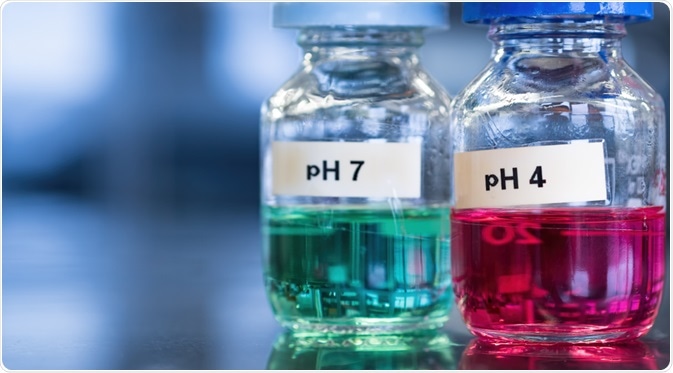pH comes from the term “power of Hydrogen”, or the hydrogen ion concentration present in a given solution. It helps to measure the acidity or alkalinity of a substance. Alkalinity or basicity are alternative terms for the same chemical characteristic.
 Image Credit: Victor Wong / Shutterstock
Image Credit: Victor Wong / Shutterstock
What is pH?
The pH is a negative logarithmic scale, which measures the molar concentration of hydrogen ions from 1 to 1014 ions. It therefore has no unit of measurement.
Numbers on a negative logarithmic scale decrease in magnitude by an order of 10 from the previous one. At a pH of 1, the hydrogen ion concentration is 10 times higher than that at 2.
The pH is thus expressed as pH = log 1/[H+] = −log [H+]. The square bracket is a symbol of the concentration of the substance.
Pure water has a pH of 7, which is considered perfectly neutral. This means that it has exactly equal numbers of hydrogen and hydroxyl ions. Any substance which is to the left of this point on the scale is considered acidic. All substances whose pH falls to the right of 7 on the scale are basic.
Just as an example, a substance with a pH of 4 on the scale is 3 points down from water with a pH of 7. On the logarithmic scale, this means a difference of 103 or 1000. Thus, the hypothetical substance is 1000 times more acidic than pure water. The strongest possible acid has one hundred trillion times more hydrogen ions than the weakest does (the weakest acid being the strongest base).
Alkalinity measures the ability of a solution to neutralize an acid. It may also describe the ability of water to act as a buffer, keeping the pH stable despite small changes in the chemistry of the water by the addition of small amounts of acids or bases. In natural water, alkalinity is caused by the weak acid salts present in it such as bicarbonates.
pH vs. Total Alkalinity in Water Chemistry | Orenda Whiteboard
Understanding acids and alkalis
In pure water, a small portion of the molecules lose one hydrogen from the H2O structure, in a process called dissociation. The water thus contains a small number of hydrogen ions, H+, and residual hydroxyl ions, OH-.
There is an equilibrium between the constant formation and dissociation of a small percentage of water molecules.
Hydrogen ions (OH-) in water join with other water molecules to form hydronium ions, H3O+ ions, which are more commonly and simply called hydrogen ions. Since these hydroxyl and hydronium ions are in equilibrium, the solution is neither acidic nor alkaline.
An acid is a substance which donates hydrogen ions into solution, while a base or alkali is one which takes up hydrogen ions.
All substances that contain hydrogen are not acidic as the hydrogen must be present in a state that is easily released, unlike in most organic compounds which bind hydrogen to carbon atoms very tightly. The pH thus helps to quantify the strength of an acid by showing how many hydrogen ions it releases into solution.
Hydrochloric acid is a strong acid because the ionic bond between the hydrogen and the chloride ions is a polar one which is easily dissolved in water, generating many hydrogen ions and making the solution strongly acidic. This is why it has a very low pH. This kind of dissociation within water is also very favorable in terms of energetic gain, which is why it happens so easily.
Weak acids are compounds which do donate hydrogen but not very readily, such as some organic acids. Acetic acid, found in vinegar, for instance, contains a lot of hydrogen but in a carboxylic acid grouping, which holds it in covalent or nonpolar bonds.
As a result, only one of the hydrogens is able to leave the molecule, and even so, there is not much stability gained by donating it.
A base or alkali accepts hydrogen ions, and when added to water, it soaks up the hydrogen ions formed by the dissociation of water so that the balance shifts in favor of the hydroxyl ion concentration, making the solution alkaline or basic.
An example of a common base is sodium hydroxide, or lye, used in making soap. When an acid and an alkali are present in exactly equal molar concentrations, the hydrogen and hydroxyl ions react readily with each other, producing a salt and water, in a reaction called neutralization.
Further Reading
Last Updated: Feb 26, 2019